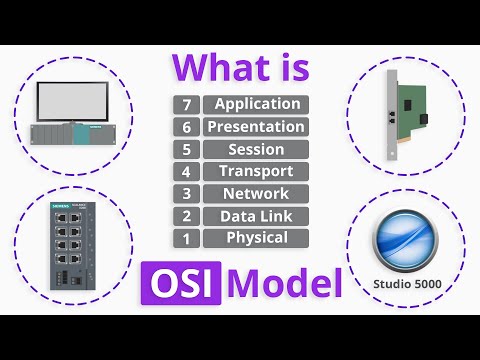✅ C'mon over to https://realpars.com where you can learn PLC programming faster and easier than you ever thought possible!
=============================
✅ Check out the full blog post over at
https://realpars.com/osi/
=============================
OSI stands for Open Systems Interconnection and is a conceptual framework for how applications communicate over a network.
There are seven layers within the model and the depiction of the layers is used to help users identify what is happening within a networking system.
The OSI model layers are typically described from the top layer down. The layers are described as Application, Presentation, Session, Transport, Network, Data Link, and Physical.
These layers are provided by a mixture of network card drivers, operating systems, applications, and networking hardware that facilitate the transmission of signals over Ethernet, Fiber Optic, Wi-Fi, or other wireless protocols.
We’ll describe the layers from the top down as the top layer is the Application layer or layer 7. This is the layer that most users interact with and will recognize.
The Application layer provides network services to the end user.
These services are protocols that work with the data the client is using. One of these protocols may be HTTP that is used with web browsers such as Google Chrome, Firefox, and Internet Explorer.
Other examples of applications that use this layer are Office, Outlook, and Skype.
All of those interactive applications provide a set of services that allow the application layer to supply data to and receive data from the Presentation layer.
The Presentation layer, or layer 6, performs the uncomplicated task of syntax processing or converting data from one format to another.
For example, say you are ordering something from an online store.
These transactions are typically handled in a secure transmission which means that the data passing between the “store” or the Website Application will transmit encrypted data to the Presentation layer that will need to be decrypted and processed.
This layer handles translating the data from the top layer, which is presented in the application format, to network format and vice versa.
After the Presentation layer processes the data from one format to another, the information is then passed to the Session layer or the Application layer depending on whether the data is transmitting or receiving.
=============================
Missed our most recent videos? Watch them here:
https://realpars.com/controlnet/
https://realpars.com/ladder-logic-vs-function-block-diagrams/
https://realpars.com/sensor-calibration/
=============================
To stay up to date with our last videos and more lessons, make sure to subscribe to this YouTube channel:
=============================
TWEET THIS VIDEO: https://ctt.ac/e9Kz7
=============================
Like us on Facebook: https://www.facebook.com/therealpars/
Follow us on Twitter: https://twitter.com/realpars
Follow us on LinkedIn https://www.linkedin.com/company/realpars
#RealPars
